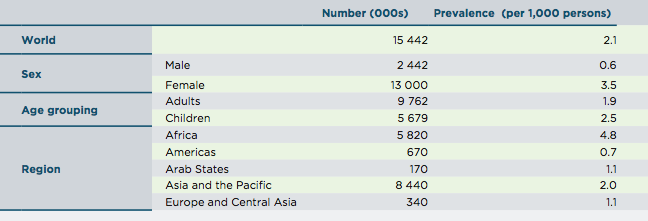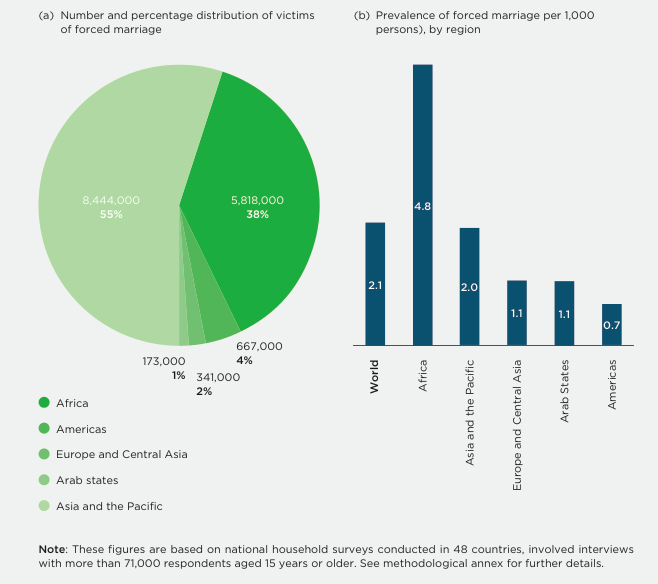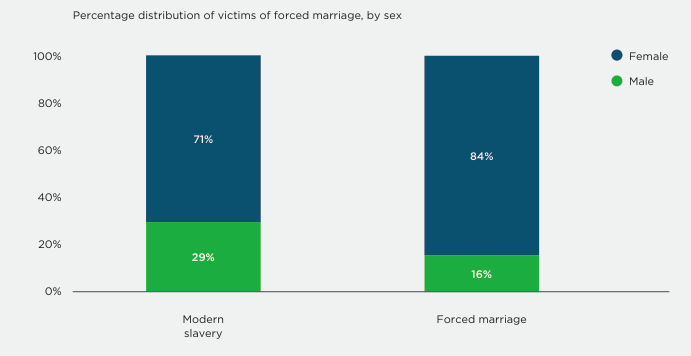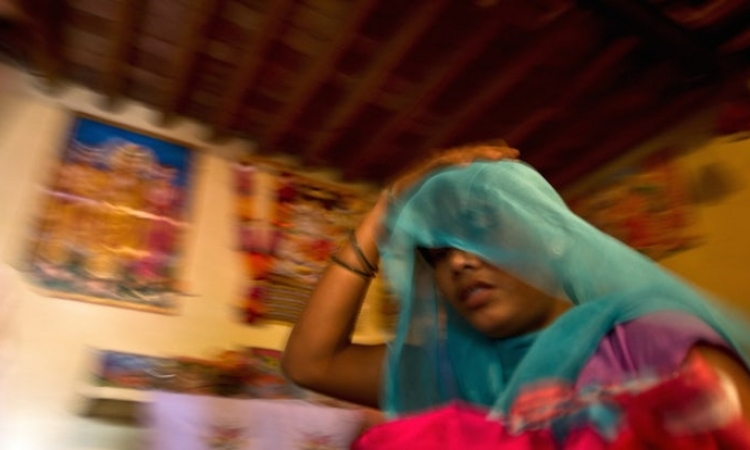The forced marriage of adults is a highly complex issue. There are societies where arranged marriages are common, and it may be difficult to assess the presence of compulsion. The coercion can be manifested in various forms, including exchange or trade-off marriages, servile marriages, and levirate 42 marriages. In some societies, a forced marriage may occur when a rapist is permitted to escape criminal sanctions by marrying the victim, usually with the consent of her family.
Forced marriages may occur in the context of migration, for example to secure the documentation extended family members needed to reside in a particular destination country. Forced marriages are also being used by armed groups during conflict. The prevalence of forced marriage in conflict and post-conflict situations needs to be examined carefully. Families who are faced with physical and economic insecurity may see early forced marriage as a way of alleviating poverty and protecting girls from difficult living conditions. Similarly, they may fall prey to traffickers who claim to offer their children a safer place and job opportunities.
Forced marriage: Number and prevalence of persons in forced marriage, by sex, age, and region

In its latest global report on trafficking in persons, the United Nations Office on Drugs and Crime (UNODC) has provided some data on trafficking for marriages, which was reported by many countries in different parts of the world during the 2012- 2014 period. Altogether, trafficking for forced or sham marriages accounts for about 1.4 per cent of the total detected victims of trafficking. Given the estimates of forced marriage in this report, this suggests forced marriage is massively under-detected. As noted in the UNODC report, trafficking for marriage takes on different permutations, from organised irregular migration and benefit fraud schemes in Europe to traditional practices in Central Asia and the Middle East (involving marriage without consent and possibly abduction), as well as the trade of women for marriages in South-East Asia. Moreover, a new mode of trafficking has surfaced in the form of a large transnational organised crime group that recruited Central European women for sham marriages in Western Europe.
As these are the first-ever global estimates of forced marriage, it is important that methods and data collection continue to evolve and grow. Some statistical information on forced marriage is now being provided at the country level. For example, a small number of countries have established Forced Marriage Units, which provide important data on referrals and cases.
In 2016, an estimated 15.4 million people were living in a forced marriage. Of this total, 6.5 million cases had occurred in the previous five years (2012-2016) and the remainder had taken place prior to this period but had continued into it.
While men and boys can also be victims of forced marriage, most victims (88 per cent) were women and girls, with more than a third (37 per cent) of victims under 18 years of age at the time of the marriage. Among child victims, 44 per cent were forced to marry before the age of 15 years. While noting limits of the data in key regions, particularly the Arab States, the data suggests prevalence of forced marriage per 1,000 people is highest in Africa (4.8 per 1,000), followed by Asia and the Pacific (2.0 victims per 1,000).
Due to the, often, unofficial and undocumented nature of most forced marriages, statistics on forced marriage vary. In 2003, the International Center for Research on Women estimated that over 51 million girls under the age of 18 were forcibly married. Forced and early marriage are most common in impoverished states in Africa, South Asia as well as the former Soviet republics. However, there are still cases of forced and early marriage in more affluent North American and European countries.
Forced marriage can be coupled with other forms of slavery. Children who are trafficked for sex may also be sold into forced marriages. An adult who is forcibly married may then be trafficked for labour or sex by and for the financial gain of his or her spouse.
International definition of forced marriage
Articles 1 and 2 of the United Nations Convention on the Abolition of Slavery, the Slave Trade and Institutions and Practices Similar to Slavery akin forced marriage to slavery. Forced marriage is an institution or practice where individuals don’t have the option to refuse or are promised and married to another by their parents, guardians, relatives or other people and groups. Early marriage is the forced marriage of a child, usually defined internationally as an individual under the age of 18.
Sometimes called servile marriage, forced marriage also occurs when a wife is forcibly transferred to another in exchange for some type of payment or when a widow is given no choice and inherited by one of her husband’s male relatives.
The key piece to forced marriage is that at least one of the marrying parties does not give his or her consent. There is no agreed-upon international minimum age for marriage consent. However, most countries set the limit at 15 or 18 years old.
United States’ definition of forced marriage
In the United States, only ten states have legislation that directly address forced marriage. The U.S. State Department recognizes forced marriage as a marriage without the consent of at least one party. Duress, threat, physical abuse and death threats by family members constitute force and coercion. In the United States, forced marriage is considered to be a human rights violation and in some cases, a form of child abuse.
An arranged marriage is differentiated from forced marriage because the marrying parties agree to the marriage arrangement in an arranged marriage.
Forced Marriage – global estimates
In 2016, an estimated 15.4 million people were living in a forced marriage. Of this total, 6.5 million cases had occurred in the previous five years (2012-2016) and the remainder had taken place prior to this period but had continued into it.
While men and boys can also be victims of forced marriage, most victims (88 per cent) were women and girls, with more than a third (37 per cent) of victims under 18 years of age at the time of the marriage. Among child victims, 44 per cent were forced to marry before the age of 15 years. While noting limits of the data in key regions, particularly the Arab States, the data suggests prevalence of forced marriage per 1,000 people is highest in Africa (4.8 per 1,000), followed by Asia and the Pacific (2.0 victims per 1,000).
Forced marriage refers to situations where persons, regardless of their age, have been forced to marry without their consent. A person might be forced to marry through physical, emotional, or financial duress, deception by family members, the spouse, or others, or the use of force, threats, or severe pressure. Forced marriage is prohibited through the prohibitions on slavery and slavery-like practices, including servile marriage. Child marriage is generally considered to be forced marriage, given that one and/or both parties by definition has not expressed full, free, and informed con- sent. However, there are exceptions. For example, in many countries 16 and 17 year-olds who wish to marry are legally able to do so following a judicial ruling or pa- rental consent.7 It is important to be clear that for the purposes of these estimates, the measurement of forced marriage is limited to what was captured by the surveys.
That is, forced marriage in these estimates includes all marriages of both adults and children that were reported by the survey respondent to have been forced and with- out consent, regardless of the age of the respondent. Accordingly, the estimates do not include every instance of child marriage, as child marriage is not currently measured adequately at the scale or specificity required for a global estimate.
An estimated 15.4 million people were living in situations of forced marriage in 2016
Forced marriage refers to situations where persons, regardless of their age, have been forced to marry without their consent. Forced marriage is prohibited through the prohibitions on slavery and slavery-like practices, including servile marriage.
There are many reasons for forced marriage, some of which are closely linked to longstanding cultural practices. In some parts of the world, young girls and women are forced to marry in exchange for payment to their families, the cancellation of debt, or to settle family disputes. In countries with significant levels of conflict, they can be abducted by armed groups and forced to marry fighters, enduring all manner of sexual, physical, and emotional abuse. Forced marriages also occur in developed nations, with women and girls being forced to marry foreign men for cultural reasons, or in order to secure another person’s entry into the country. Once forced to marry, many victims are placed at greater risk of being subjected to other forms of exploitation, including sexual exploitation, domestic servitude, and other forms of forced labour. Children are especially vulnerable in these situations.
An estimated 15.4 million people were living in situations of forced marriage in 2016. In a total of 6.5 million of these cases, the forced marriage occurred during the five-year period from 2012 to 2016, while the remainder occurred prior to this period but continued into it.40 In terms of prevalence, 2.1 out of every thousand persons worldwide were living in forced marriage in 2016. It is important to note that the measurement of forced marriage is at an early stage and both the scope and the methodologies are likely to be further refined. Accordingly, the current estimates should be considered to be conservative.
Forced marriage across regions

The Africa region and the Asia and the pacific region had the highest number and prevalence of forced marriage
More than 90 per cent of all forced marriages took place in two regions: Africa and Asia and the Pacific. The prevalence was by far the highest in Africa at 4.8 victims for every 1,000 people, followed by the Asia and the Pacific region (2.0 per 1,000), and then by the Europe and Central Asia region and the Arab States region (1.1 per 1,000) and the Americas (0.7 per 1,000). These regional figures, however, were affected by differences across regions in data availability. There are numerous reports of forced marriage in Central Asia and the Arab region,41 for example, but few surveys on the issue have been conducted there.
Forced marriage by sex

Most victims of forced marriage were women and girls
An estimated 13 million women and girls were living in a forced marriage in 2016, representing 84 per cent of all victims of forced marriage. The share of females in forced marriage is substantially higher than the share of females in all forms of modern slavery (84 per cent versus 71 per cent).
More than one-third of victims living in a forced marriage were children at the time of the marriage; almost all child victims were girls
An estimated 37 per cent of victims living in forced marriage were children at the time the marriage took place. Among child victims, 44 per cent were forced to marry before the age of 15 years. The youngest victims of forced marriage in the sample were nine years of age at the time they were forced to marry. Girls were more much likely to be forced to marry than boys; 96 per cent of all child victims were girls. Child marriage is generally considered to be forced marriage, given that one and/or both par- ties by definition has not expressed full, free, and informed consent. However, it is important to be clear that for the purposes of these estimates, the measurement of forced marriage is limited to what was captured by the surveys. That is, forced marriage in the estimates includes all marriages of both adults and children that were reported by the survey respondent to have been forced and without consent, regardless of the age of the respondent. Accordingly, the estimates do not include every instance of child marriage, as child marriage is not currently measured adequately at the scale or specificity required for a global estimate.
IMAGE CREDIT: The New Republic / Mana Vatsyayana

